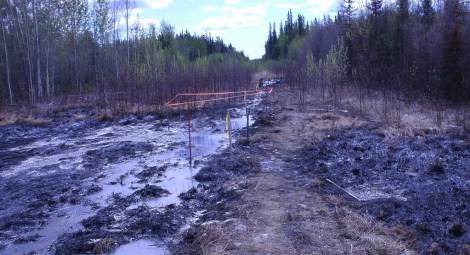A major spill of toxic oil waste has wiped out trees and vegetation across a 104-acre swath of Alberta, Canada. The apparent cause of the spill: The rupture of a five-year-old pipeline that was designed to last at least 30 years.

Dene Tha via Nathan VanderKlippeApache’s oil spill in Alberta
The pipeline spilled 2.5 million gallons of a waste mixture of oil and water, which the company responsible, Houston-based Apache Corp., downplayed as “salty water” with “trace amounts of oil.”
Whatever you call it, it’s nasty stuff. “Every plant and tree died” in the area touched by the spill, says the chief of the nearby Dene Tha First Nation, while The Globe and Mail reports that “aerial photos show a broad strip of trees that have turned brown.”
It’s unclear when the pipeline started spilling. Judging by the damaged trees in the area, the Dene Tha say the leak might have been sprung in the winter. But the spill was only revealed publicly this week by the province’s energy regulators following media reports.
Tim Wall, president of Canadian operations for Apache, said it is “kind of puzzling” why the pipeline leaked. “We just need to get this all cleaned up, get it reclaimed, do the remediation – then we’ll figure out what happened.”
[The spill] comes amid heightened sensitivity about pipeline safety, as the industry faces broad public opposition to plans for a series of major new oil export pipelines to the U.S., British Columbia and eastern Canada. …
The leak follows a pair of other major spills in the region, including 800,000 litres of an oil-water mixture from Pace Oil and Gas Ltd., and nearly 3.5 million litres of oil from a pipeline run by Plains Midstream Canada.
After those accidents, the Dene Tha had asked the Energy Resources Conservation Board, Alberta’s energy regulator, to require installation of pressure and volume monitors, as well as emergency shutoff devices, on aging oil and gas infrastructure. The Apache spill has renewed calls for change.
“We don’t believe that the government is doing enough to ensure upgrades and maintenance of the lines,” Mr. Ahnassay said.
If Keystone XL is approved, we can look forward to a lot more tar-sands oil mining in Alberta, and a lot more spills like this one.


